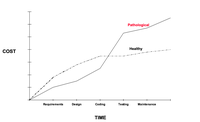Software reviews – does high-quality software justify its cost?
What are the benefits of software reviews?
Software reviews lead to significantly fewer errors. According to a study of 12 thousand projects by Capers Jones [1], these are reduced by
- in requirements reviews by 20–50 percent
- in top-level design reviews by 30–60 percent
- in detailed functional design reviews by 30–65 percent
- for detailed logical design reviews by 35–75percent
The study concludes:
Poor code quality is cheaper until the end of the code phase; after that, high quality is cheaper.
The study still assumes a classic waterfall model from requirements to software architecture, first to code, then to tests and operation. In agile software development, however, this process is repeated in many cycles, so that we spend most of our time developing software by changing or adding to the existing code base. Therefore, we need to understand not only the change requirements but also the existing code. Better code quality makes it easier for us to understand what our application does and how the changes make sense. If code is well divided into separate modules, I can get an overview much faster than with a large monolithic code base. Further, if the code is clearly named, I can more quickly understand what different parts of the code do without having to go into detail. The faster I understand the code and can implement the desired change, the less time I need to implement it. To make matters worse, the likelihood that I will make a mistake increases. More time is lost in finding and fixing such errors. This additional time is usually accounted for as technical debt.
Conversely, I may be able to find a quick way to provide a desired function, but one that goes beyond the existing module boundaries. Such a quick and dirty implementation, however, makes further development difficult in the weeks and months to come. Even in agile software development without adequate code quality, progress can only be fast at the beginning, the longer there is no review, the tougher the further development will be. In many discussions with experienced colleagues, the assessment was that regular reviews and refactorings lead to higher productivity after just a few weeks.
Which types of review solve which problems?
There are different ways to conduct a review. These depend on the time and the goals of the review.
The IEEE 1028 standard [2] defines the following five types of review:
- Walkthroughs
- With this static analysis technique we develop scenarios and do test runs, e.g. to find anomalies in the requirements and alternative implementation options. They help us to better understand the problem, but do not necessarily lead to a decision.
- Technical reviews
- We carry out these technical reviews, e.g. to evaluate alternative software architectures in discussions, to find errors or to solve technical problems and come to a (consensus) decision.
- Inspections
- We use this formal review technique, for example, to quickly find contradictions in the requirements, incorrect module assignments, similar functions, etc. and to be able to eliminate these as early as possible. We often carry out such inspections during pair programming, which also provides less experienced developers with quick and practical training.
- Audits
- Often, before a customer’s software is put into operation, we conduct an evaluation of their software product with regard to criteria such as walk-through reports, software architecture, code and security analysis as well as test procedures.
- Management reviews
- We use this systematic evaluation of development or procurement processes to obtain an overview of the project’s progress and to compare it with any schedules.
Customer testimonials
«Thank you very much for the good work. We are very happy with the result!»
– Niklas Kohlgraf, Projektmanagement, pooliestudios GmbH
Get in touch
I would be pleased to answer your questions and create a suitable offer for our software reviews.
We will also be happy to call you!
| [1] | Capers Jones: Software Quality in 2002: A Survey of the State of the Art |
| [2] | IEEE Standard for Software Reviews and Audits 1028–2008 |


